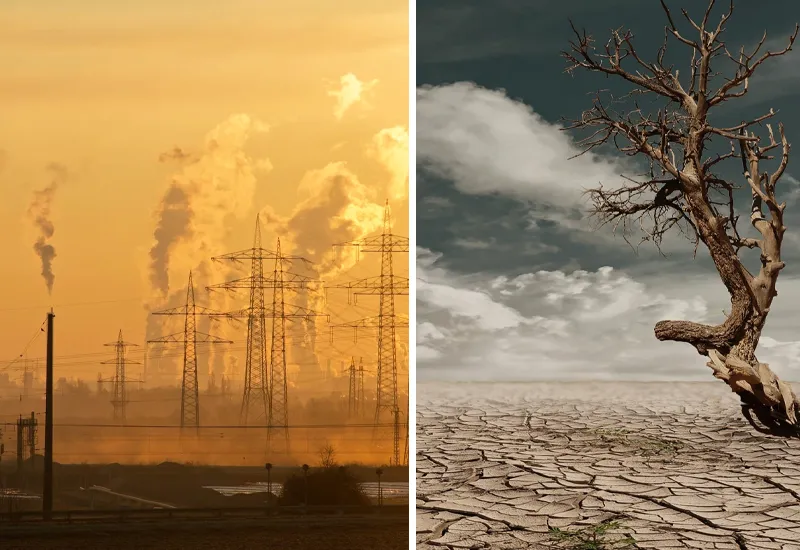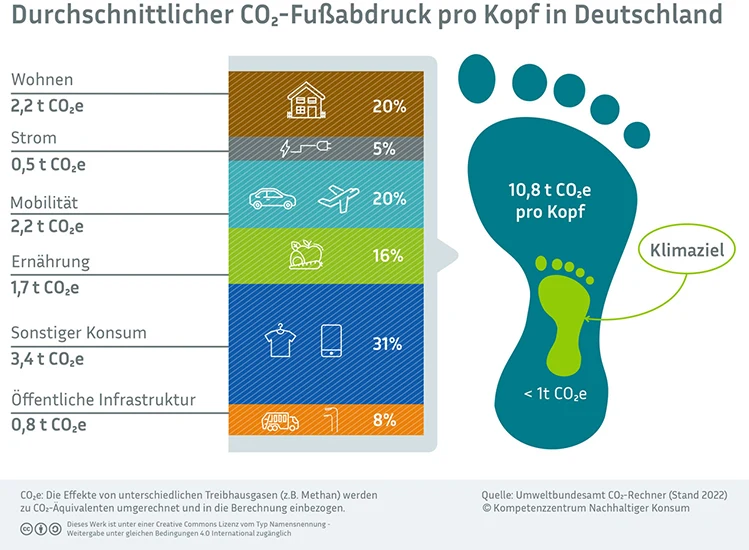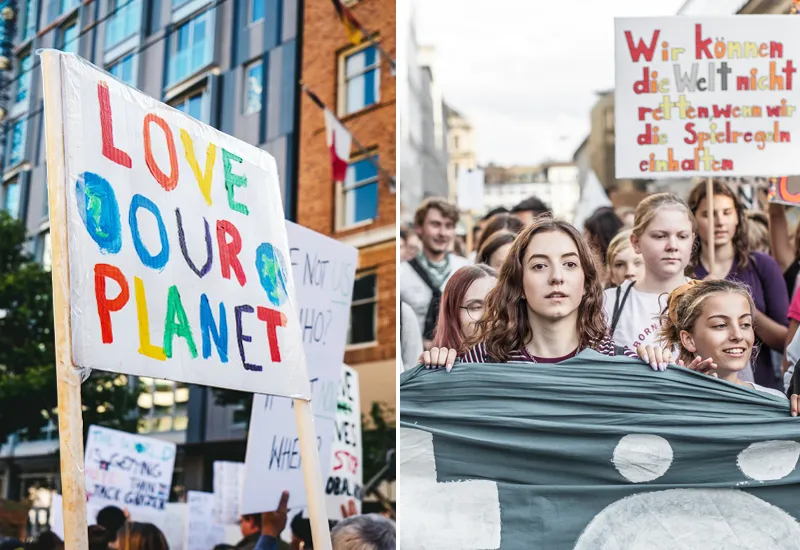You want to save CO2 in your everyday life and reduce your carbon footprint? Then you've come to the right place! The Climate Change is one of the biggest problems of our time. Since we humans ourselves contribute significantly to it through our greenhouse gas emissions, we cannot avoid adapting our lifestyles and behavior.
Globally, 4.7 metric tons of CO2 were emitted per inhabitant of the earth in 2021. In the industrialized nation of Germany, per capita carbon dioxide emissions in the same period were as high as 8.09 metric tons.₁ The Climate BudgetHowever, the maximum amount that each person on this planet would be entitled to annually in order to achieve the 1.5-degree target set out in the Paris Agreement is around 1.5 metric tons.
That sounds like a truly Herculean task! But in fact we have countless options at our disposal to make our lives more climate-friendly.
In this article, I would like to give you the best tips on how you can save CO2 in your own everyday life and make a real difference for the climate. Before you do, you'll also learn about all the motives and some policy measures. Let's go!
In advance you can find a short overview of the article here:
Motives: Why should we save CO2 in the first place?

For a high level of motivation - and because the climate problem is not really tangible for many people - I would like to explain the reasons for CO2 saving measures. But first I must directly clear up two misunderstandings and counterargumentswhich I often hear.
Misconception #1: "We Germans have hardly any influence on the climate".
Although Germany "only" has a two percent share of global CO2 emissions - but when we look at per capita consumption, we are one of the biggest climate sinners in a global comparison of countries. Moreover, it was still never particularly smart to shift the blame onto othersto not have to adapt and change themselves.
Misconception #2: "CO2 compensation is enough after all".
You could also just use your own Offset CO2 emissions - for example by making a donation to a climate protection organization. The attitude is basically very commendable. However, it is much more environmentally and climate friendly if they are not created in the first place..
The most important advantages and reasons at a glance
Motifs, why we live sustainably and save CO2 are manifold and closely interconnected. At the forefront above all is the Climate protectionGlobal warming has serious consequences for all areas of life on earth. The anthropogenic greenhouse effect (caused by man-made, climate-damaging gases such as CO2) is making a decisive contribution to the increasing temperature of our planet. Today, around 40 percent more CO2 is measured in the atmosphere than at the beginning of the industrial age.₂
"We deal with this world as if we had a second one in the trunk."
Jane Fonda (more at Climate protection quotes)
By reducing our CO2 emissions, we can make a direct contribution to climate protection and limit the extent of global warming and its consequences for our own lives.
Here I have given you the most important Advantages of the CO2 reduction measures once clearly compiled:
- Environment: Ecosystems remain in balance and also the Environmental problem of species extinction decreases because the earth heats up less quickly.
- Health: Less CO2 in most cases also means less Air Pollution and thus better condition for it, stay healthy in the long term. Increasing heat and the rising likelihood of momentous extreme weather are also major threats to our health.
- Respect: Saving CO2 is also a respectful gesture towards the people who are already suffering massively from climate change (for example, due to rising sea levels).
- Resource conservation: Many CO2 reduction measures also lead to lower consumption of natural resourcesso that the planet's treasures can be preserved for future generations.
- Economic efficiencyClimate-neutral or CO2-saving measures and products are generally more favorable and economical in the long term - whether from the perspective of companies or private households. In addition, the local economy is also specifically promoted.
In summary, the reduction of the carbon footprint contributes to a more sustainable, healthier and fairer planet. It's a win-win-win for you, the community and the earth.
Politics: What climate protection measures are being implemented in the European Union and in Germany?

The EU and Germany are pursuing clear goals on the road to greenhouse gas neutrality. Compared with 1990, Germany is to cut 65 percent of its greenhouse gas emissions by 2030 - and by as much as 88 percent by 2040. By 2045, our country should be climate-neutral. To achieve this, the so-called Climate Protection Act adopted.
At EU level, the European climate law the basis for achieving the European Union's climate target of reducing its own greenhouse gas emissions by at least 55 percent by 2030 - and for achieving climate neutrality by 2050.₃
The "Fit for 55 Package
The so-called "Fit for 55 package" takes its name from the EU target just mentioned and includes Proposals to revise and update EU legislation. It sets clear targets and specifies the following objectives and measures₄:
- EU Emissions Trading Scheme: A type of CO2 market that has already reduced emissions in the EU by 41 percent since its introduction in 2005.
- Climate Social Fund: It is designed to offset the social and distributional impacts of emissions trading on the buildings and transport sectors.
- Carbon Boundary Adjustment Scheme (CBAM): This is to prevent the effect of CO2 reduction measures in the EU from fizzling out. This could be the case, for example, if production is outsourced to non-EU countries with low climate protection requirements.
- Emission reduction targets of the member states: Every country in the EU must adhere to these binding targets for annual reductions in greenhouse gas emissions.
- LULUCF Regulation: For reducing greenhouse gas emissions from land use, land use change, and forestry.
- Regulation on CO₂ standards: The transport sector accounts for around one-fifth of emissions in Germany - and the trend is rising. This regulation therefore revolves primarily around specifications in the area of mobility. A significant proportion of these emissions are attributable to commercial vehicles. Alternative drives and fuels as well as new technologies for trucks are therefore an important project in the German government's 2030 climate protection program.
- Revised Renewable Energy Directive: By 2030, at least 40 percent of the total energy mix in the EU is to come from renewable sources.
- Energy efficiency: Compared with forecasts from 2020, there is to be a reduction in final energy consumption at EU level of 11.7 percent by 2030. In addition, all new buildings are to be so-called zero-emission buildings by 2030.
- hydrogen market and the decarbonized gas market: Here, the CO2 footprint of the gas market is to be successively reduced.
- Energy taxation: Adapted to the EU's energy, environmental and climate policies, one of the aims is to create new revenue-generating capacity for member states' budgets.
How realistic are the objectives and how effective are the measures?
According to assessments by the European Court of Auditors the European Union will fall short of its CO2 reduction targets despite all the targets and measures. The agency's special report also explicitly criticized Germany for failing to independently meet its own greenhouse gas targets for 2020.
In the period from 2013 to 2020, Germany had to around 17 million tons CO2 equivalent of greenhouse gas emission allocations from other EU countries that had actually exceeded their targets.₅
10 tips: How can each of us reduce our own carbon footprint?

Many people see politics as having a responsibility - and this is fundamentally correct, since it sets the framework conditions for a more sustainable lifestyle prescribes. But, of course, politics does not bear them alone - and apart from that, the (interim) goals are apparently not even being achieved. So it is primarily up to us consumers as well - not least because our demand for climate-friendly alternatives determines the supply of the economy.
So let's take a closer look at what each of us can do in our everyday lives to save CO2! Every little change can make a big difference. Use the following tips and ideas now to reduce your carbon footprint and make a positive contribution to the planet.
Here again I have given you a little Overview prepared:
- Reduce hot water
- Save heating energy
- Use green power and save electricity
- Prefer bus, train and bicycle to car and plane if possible
- Prefer electric car to combustion car and use it ecologically
- Modernize building
- Eat organic, regional, seasonal and plant-based food
- Avoid waste and waste of resources
- Conscious consumption
- Becoming active for climate protection
Notice: If appropriate, I will also link you to more specific tips and further blog posts.
1. reduce hot water

According to the Federal Environment Agency the provision of hot water in German households accounts for an average of around twelve percent of total energy consumption. Hot water for Showers or for a cozy Foam bath therefore has a significant impact on its own carbon footprint.
To get your (warm)Reduce water consumption you can for example shorter and Shower colder, the Turn off water when brushing teeth, a Water saving shower head install and the Washing machine only turn it on when it is really full. Through these measures you can save every year quite 400-600 kilograms of CO2.
2. save heating energy
If you want to live as climate-neutrally as possible and minimize your CO2 emissions, you should also think about the efficient and sustainable use of heating energy inform
For one thing, it is important to note, What technique heats your rooms and the water. In this respect, heat generation by a geothermal heat pump is one of the most sustainable technologies - in contrast to oil or gas heating systems.
On the other hand, even with older building technology, you still have the opportunity to consciously save heating energy and thus heating costs and CO2.
For example, make sure to use the Do not keep room temperature unnecessarily high and wear warm clothes instead. Ventilate your rooms briefly and intermittently, instead of leaving the windows tilted all day, so that the heat stays in the room. Furthermore, you should only heat rooms that really need to be warm because you spend time in them. This way you have the chance to save up to 600 kilograms of CO2 every year.
3. use green power and save electricity
You can lay the foundation for climate-friendly use of technology in your home by making a Switch to a green power supplier*. Finally, your electricity then comes from regenerative energy sourcessuch as wind, solar or hydropower.
In addition, of course, you should generally look for a Economical use of the available electricity pay attention. For example, turn off all your devices completely instead of leaving them in standby mode. Also give preference to energy-efficient technology (e.g., refrigerator, television, washing machine, and lighting) if you have the ability to do so.
Also Timers, Motion detector, the Laundry drying on the line instead of in the dryer, as well as the Cooking with lidcan help you save energy in the household and thus also CO2.
4. give preference to bus, train and bicycle over car and plane wherever possible

The transport sector is one of the biggest CO2 emitters. In your everyday life, therefore, think carefully about whether a particular car trip or short flight is absolutely necessary. Use - whenever possible - public transportation, the Bike or walk.
For somewhat longer distances (for example, with the most possible sustainable journey) are Train rides in many cases a not only more climate-friendly but also more relaxed alternative to flying.
Sometimes, however, trips can be avoided altogether! For example, if you want low-emission and environmentally friendly in the Home Office work - or conduct a meeting with business partners online instead of traveling to them. By the way, you also gain a lot of time in your daily routine for a better work-life balance.
Tip: Fittingly, I have written you an article about "lasting feelings of shame" which also deals with the shame of flying. Many people refrain from flying because they have a guilty conscience when they blow huge amounts of greenhouse gases into the earth's atmosphere by plane.
5. prefer electric car to combustion car and use it ecologically.
Extremely sustainable it is, not to use a car at all. However, if you are dependent on a car, you should, if possible, use the biggest advantage of the electric car use when charged with electricity from renewable sources, it runs emission-free. This way you can reduce your CO2 emissions over many years. But keep in mind that the production of the car also causes CO2 emissions, which is why it is important to use a car for as long as possible.
In principle, a climate-friendly car should in any case be as small, light and economical as possible be. If you already own a gasoline or diesel engine, or have just purchased a used combustion engine, your carbon footprint can also be improved by a sustainable driving style and the efficient Use improve significantly.
Form for example Carpools with colleagues, use Carsharing-Switch off the car when it is stationary, reduce its weight as much as possible, and try to combine as many everyday errands as possible with a single trip.
Tip: You want to practice more climate protection in everyday life? Then take a look at the related article about the sustainable way to work an.
6. modernize building
Through an energetic renovation you can ensure that your home or rented apartment is will become more energy efficient in the next decades and much less thermal energy will be lost. A sustainable thermal insulationmodern windows or efficient heating systems can make a real difference.
As an owner:in you even benefit from state subsidies. And also as tenant:in you can convince your landlords to implement climate-friendly modernization measures. For example, with the argument that the rental apartment will remain attractive for tenants in the long term because heating costs can be saved.
7. organic, regional, seasonal and plant-based diet

The ecological footprint of animal foods (e.g. meat, butter or eggs) is really massive. For example, to produce one kilogram of organic beef requires 21.7 kilograms of CO2 equivalent.₆ No wonder, since the animals have to be fed and kept, after all - and since ruminants emit large amounts of the climate-damaging gas methane.
So, of course, much more environmentally friendly is to eat the grown plants directly. Meat eaters making the switch to a vegan diet master, can certainly save more than one ton of CO2 per year.
In principle, try to do this as plant-based, organic and seasonal food from regional, organic farming to prefer. Short transport routes, no resource-intensive "detour via the animal", cultivation without energy-intensive greenhouses, but also the renunciation of synthetic fertilizers and pesticides, drastically reduces the CO2 emissions for your meals.
Tip: Animal welfare and climate protection are among my personal Reasons why I live vegan. In the united article you will learn what else motivates me to do this.
8. avoid waste and waste of resources
The production and combustion of just one ton of plastic alone produces about five tons of CO2 emissions.₇ So if you want to use less carbon dioxide in your life, you should reduce the Zero Waste Lifestyle adapt and try to produce as little waste as possible.
Replace disposable alternatives with Reusable products (e.g. plastic straws through Glass straws*), prefer recycled products, try to use items for as long as possible, buy food unpackaged and try not to throw away any more food if possible. Thus you save the earth's resources every day.
9. consume consciously
Basically, it is necessary to have a avoid resource-intensive new purchases and live minimalistif you want to emit less CO2.
For each potential purchase, consider whether you really need the product - and if so, whether there is not a more sustainable alternative. For example, I always think of the Used purchase through classified ads or in the second-hand store. There is also the possibility of borrowing consumer goods.
And if you do buy something new: avoid impulse purchases and rather invest thoughtfully in high-quality, durable products that you then treat and care for well. This is incredibly important, especially in the area of fashion. Also bypass imported goods from abroad at the sustainable online shoppingto avoid long, CO2-intensive transport routes.
10. becoming active for climate protection

As individuals, we can do a lot in our own daily lives - but of course we can't save the climate all by ourselves! To save the multiply your own impact a thousandfoldTherefore, if possible, you should also advocate for climate protection on a social level.
Set a good example! Inform others about the reasons and opportunities for CO2 savings, participate in demonstrations, support environmental organizations and start petitionsin order to uncover and change grievances. Every vote counts and can help to ensure that politics and the economy are more strongly oriented towards climate protection.
Tip: Also talk to your friends and family about the problem and the opportunities to actively save CO2. For example, how you can Inspire parents for sustainabilityI will explain this in a separate blog article.
Save CO2: Use tips to reduce your carbon footprint
Whether it's a plant-based diet, public transportation, saving energy or avoiding waste, now you know how to save CO2 in your everyday life. Just try to put the knowledge from this article into practice step by stepso that your children and grandchildren - and all future generations - can also enjoy life on earth.
"Ultimately humanity is one, and this small planet is our only home. If we're to protect this home of ours, each of us needs to experience a vivid sense of universal altruism and compassion."
Dalai Lama (more at Environmental protection quotes)
However, please don't forget that the path to the lowest possible carbon, carbon-neutral lifestyle is is a marathon and not a sprint - No one expects you to implement all the tips perfectly at once.
In conclusion, I have here some continue blog articlethat could make your everyday life even more environmentally friendly:
- Stop climate change - The most valuable climate protection tips
- Climate tipping points - What do we mean by this?
- What Is The Difference Between Weather And Climate?
I really hope that my tips for saving CO2 will help you and that you will get a little bit closer to a climate-friendly lifestyle every day. Do you have any questions, suggestions or further tips to reduce your carbon footprint? Then I look forward to your comments.
Stay sustainable,

PS: Not only your consumer behavior shapes the world of tomorrow! Also through a conscious and sustainable investment With every cent you spend, you can help make our way of life fairer, more equitable and more environmentally friendly. I'll explain how this works in the linked blog post.
References:
₁ IEA; Global Carbon Atlas: Energy-related CO2 emissions per capita worldwide by selected countries in 2021 (as of September 2022), available at https://de.statista.com/statistik/daten/studie/167877/umfrage/co-emissionen-nach-laendern-je-einwohner. [28.06.2023].
₂ myclimate foundation: What is the greenhouse effect? (as of 01.03.2022), available at https://www.myclimate.org/de/informieren/faq/faq-detail/was-ist-der-treibhauseffekt. [28.06.2023].
₃ Bavarian State Ministry for the Environment and Consumer Protection: European Climate Act (EU) 2021/1119, available at https://www.umweltpakt.bayern.de/energie_klima/recht/eu/455/europaeisches-klimagesetz-eu-20211119 [28.06.2023].
₄ European Council: "Fit for 55," available at https://www.consilium.europa.eu/de/policies/green-deal/fit-for-55-the-eu-plan-for-a-green-transition. [28.06.2023].
₅ ZEIT Online: Climate Protection - European Court of Auditors Doubts Achievement of EU Climate Targets (as of 06/26/2023), available at https://www.zeit.de/wissen/umwelt/2023-06/eu-rechnungshof-klimaziele-treibhausgasemissionen. [28.06.2023].
₆ Ivy (2020): Ecological footprint of meat, fish and meat alternatives in Germany in 2019, available at https://de.statista.com/statistik/daten/studie/1197941/umfrage/co2-fussabdruck-von-fleisch-fisch-und-fleischalternativen-in-deutschland. [28.06.2023].
₇ P. Jasper: Towards climate neutrality: plastic recycling must be given greater focus (as of June 30, 2021), available at https://www.diw.de/de/diw_01.c.820601.de/auf_dem_weg_zur_klimaneutralitaet__plastikrecycling_muss_staerker_in_den_fokus_ruecken.html. [28.06.2023].









